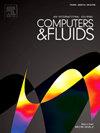A Parametric Design Study of Natural-Convection-Cooled Heat Sinks
IF 2.5
3区 工程技术
Q3 COMPUTER SCIENCE, INTERDISCIPLINARY APPLICATIONS
引用次数: 0
Abstract
Effective natural-convection-cooled heat sinks are vital to the future of electronics cooling due to their low energy demand in the absence of an external pumping agency in comparison to other cooling methods. The present numerical study was carried out with ANSYS Fluent and aimed at identifying a more-effective fin design for enhancing heat transfer in natural convection applications for a fixed base-plate size of 100 mm × 100 mm under an applied heat flux of 4000 W/m2. The Rayleigh number used in the present study lied within the range of 2.6 × 106 to 4.5 × 106. Initially, a baseline case with rectangular fins was considered in the present study, and it was optimized with respect to fin spacing. This optimized baseline case was then validated against the semi-empirical correlation from the scientific literature. Upon good agreement, the validated model was used for comparative analysis of different heat sink configurations with rectangular, trapezoidal, curved, and angled fins by constraining the surface area of the heat transfer. The optimized fin spacing obtained for the baseline case was also used for the other heat sink configurations, and then, the fin designs were further optimized for better performance. However, for the angled fin case, the optimized configuration found in the scientific literature was adopted in the present study. The proposed novel curved fin design with a shroud showed a 4.1% decrease in the system’s thermal resistance with an increase in the heat transfer coefficient of 4.4% when compared to the optimized baseline fin case. The obtained results were further non-dimensionalized with the proposed scaling in terms of the baseline case for the two novel heat sink cases (trapezoidal, curved).自然对流冷却散热器的参数化设计研究
与其他冷却方法相比,有效的自然对流冷却散热器在没有外部泵送机构的情况下能耗低,因此对电子冷却的未来至关重要。本数值研究采用ANSYS Fluent软件进行,旨在确定一种更有效的翅片设计,以增强自然对流应用中100 mm × 100 mm的固定底板尺寸,在4000w /m2的施加热流密度下的传热。本研究使用的瑞利数在2.6 × 106 ~ 4.5 × 106之间。首先,在本研究中考虑了矩形鳍的基线情况,并对鳍间距进行了优化。然后,根据科学文献中的半经验相关性验证了该优化基线病例。通过对传热面积的限制,将验证模型应用于矩形、梯形、弯曲和角度翅片的不同散热结构的对比分析。在此基础上,将优化后的翅片间距应用于其他散热片构型,进一步优化散热片的设计,以获得更好的散热性能。然而,对于有角度的翅片情况,本研究采用了科学文献中发现的优化构型。与优化后的基准翅片相比,采用带护罩的新型弯曲翅片设计后,系统热阻降低4.1%,换热系数提高4.4%。根据两种新型散热器情况(梯形,弯曲)的基线情况,所获得的结果进一步无因次化。
本文章由计算机程序翻译,如有差异,请以英文原文为准。
求助全文
约1分钟内获得全文
求助全文
来源期刊

Computers & Fluids
物理-计算机:跨学科应用
CiteScore
5.30
自引率
7.10%
发文量
242
审稿时长
10.8 months
期刊介绍:
Computers & Fluids is multidisciplinary. The term ''fluid'' is interpreted in the broadest sense. Hydro- and aerodynamics, high-speed and physical gas dynamics, turbulence and flow stability, multiphase flow, rheology, tribology and fluid-structure interaction are all of interest, provided that computer technique plays a significant role in the associated studies or design methodology.
 求助内容:
求助内容: 应助结果提醒方式:
应助结果提醒方式:


